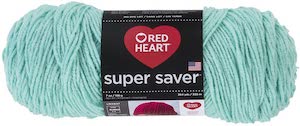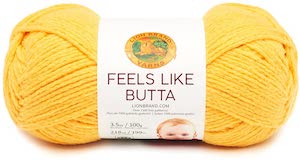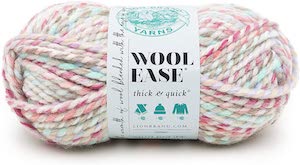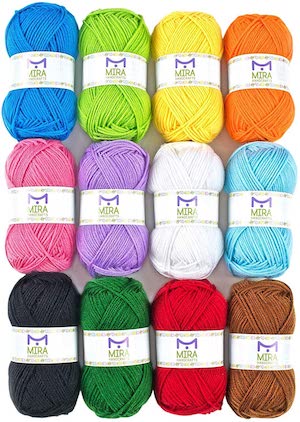Lounging on your favorite armchair with knitting needles and a ball of yarn at your feet is no longer “just for grannies.” People of all ages are getting hooked to knitting for relaxation.
If you are just getting started, you’ll be surprised at how much easier it is than it seemed. With a little enthusiasm, you might even have several warm, fancy-looking, DIY knits ready by winter.
However, yarn that is not newbie-friendly can water down all your attempts to learn the skill quickly. It could also negatively affect how your stitches and, eventually, the finished apparel turns out, killing your morale.
What is the best yarn for knitting beginners? The best yarn for knitting beginners is worsted weight yarn, but anything in the middle range of weights to slightly thicker weights are safe choices. Acrylic, cotton, wool, and any other yarn that is not too slick are the easiest materials to work with.
Experienced knitters agree that it is the easiest to use. But there are other qualities that make a yarn either beginner-friendly or not, for example, the color, texture, and even the type of fiber.
You don’t have to overthink things if it’s your first time purchasing yarn. This post is dedicated to guiding newbies like you through the yarn selection process.
You’ll learn what factors are key when choosing beginner-friendly knitting yarn. We simplify the process further by recommending the 7 best yarns for beginner knitters at the very end. Let’s go yarn hunting!
Yarn For Beginner Knitting: Things To Look For
All yarn tends to look the same if you’re not familiar with them yet.
The truth is, though, one skein couldn’t be far different from another. They all feel and act differently. Each of these yarns has distinct characteristics. And even though you may prefer certain fibers for your knits, it doesn’t necessarily make them the best for your skill level.
Here are a few factors to help you zero in on the right yarn for beginner knitting.
Material
Yarn can be spun from natural fibers, synthetic fibers, or a blend. Therefore, you are likely to come across cotton, wool, silk, linen, polyester, and acrylic yarns, just to mention but a few.
So, what is the best yarn material for beginner knitting? Wool yarn is often thought to be the best yarn for beginner knitting.
It has some give, which is an essential feature for beginners, but it also has a tendency to “hold” stitches, so if your loops slide off while you’re getting used to your needles, your stitches aren’t likely to go anywhere. You can usually just slide them back on.
When starting to knit, you are bound to make mistakes, particularly when your stitch tension is inconsistent. A little stretch is good for concealing these flaws, and wool yarn has that kind of elasticity. It also has a good working texture.
Sometimes, specific projects require cotton, say you want to knit washcloths. Perhaps you are allergic to wool or prefer non-animal products for ethical reasons.
In any such case, you may opt for cotton yarn for a natural plant fiber yarn or good quality acrylic yarn for a synthetic option. It does not have wool’s kind of resilience, but it is still much easier for learning than some other fibers like linen which is too stiff, or silk, which may be too slippery. Blends are fantastic too.
Many acrylic yarns are also easy to work with. Just stay away from anything that has a silky or super soft texture; if it advertises a cashmere or silky texture, put it down! It’s not worth the frustration.
Weight
When we talk about yarn weight, we refer to the thickness of the strands and not the actual weight of the yarn in oz or grams.
If you check the yarn description, it will often be labeled with the weight number, name, or both. This number could be between 1-6. The names vary depending on where the yarn was made. 1 is superfine weight, 2 is a fine weight, 3 is a light weight, 4 is medium weight, and 5-6 are bulky and super bulky weight yarns.
Some weight names you might come across include lace, baby, fingering, DK, sport, light worsted, worsted, Aran, chunky, bulky, super bulky, jumbo, or roving yarn (in rough order from lighter to thick, though some variation can occur between skeins).
Worsted-weight yarn, usually #4, is the ideal size for novice knitters. The thickness is manageable making the strands and needles easy to manipulate. The stitch definition is also adequate to spot any mistakes made; plus the stitches will turn out nicely. This weight is also known as Aran or Afghan weight.
As a beginner, you may try a #5 or even #3. Most find it easier to opt for thicker yarns as well as medium weights, but #6 may be a little too chunky; you may want to try it before committing to a whole project.
You should also feel comfortable trying light worsted, sport, DK, or slightly bulky yarns. Again, the further you stray from medium worsted weight the harder it could be, but as these are all in the middle of the range, they’re still options.
A DK 3 and chunky 5 are good alternatives, in case you are more comfortable with a size thinner or thicker respectively.
Try to figure out if you prefer to go smaller or thicker and adjust from there.
With thinner yarns, your progress will be snail-paced. It is more difficult to single out errors as well and you may notice them when you are already many rows ahead.
Chunkier yarns work up fastest, and mistakes will readily glare at you, which is great. You can unravel and correct it before you get too far.
However, the thicker needles needed to knit with these types of yarn may prove challenging to handle. But then, some have that problem with thinner needles – it’s a personal thing. If you tend to need bigger tools, it’s fine to go up. If you know you prefer smaller, more precise tools, feel free to stick to lighter mediums.
Color
Surprised? We know, because one often chooses their color palette based on personal taste.
Notwithstanding, dark tones are not newbie-friendly. They are actually harder to see, especially with the tightness and neatness of your stitches as you progress. Also, you may be unable to notice mistakes as soon as you make them in dark shades.
Lighter to in-between colors are the best for learning! Therefore, you want to stay away from black, coffee, navy, and other dark shades. Go for any creams, pastels, and medium colors you like.
Opt for solids as well; variegated and self stripping multicolored yarns are flashy, but can be confusing when trying to ‘read’ your stitches as a beginner.
Shape
Yarn comes packaged in different shapes: balls, skeins, cakes, hanks, cones. Does it matter what shape you choose?
Well, the shape doesn’t really matter in terms of the outcome of your knit. However, some shapes are easier to pull from than others. And you are all after an easy tangle-free time, right?
Let’s help you identify these shapes first. Balls are spherical while cakes are rounded with a flat bottom and sit stable on a surface.
Skeins are what you probably find the most in stores. They’re long and might be skinny; you can pull from inside the skein (recommended) or the outside (fine, but not as easy and more likely to tangle at the end).
Hanks have the classic oblong shape, and hanks have a double rope twist appearance but unravel into a ring. Hanks are not ready to use unless you want to mess up the yarn and spend more time detangling it. It would help if you first wind it into a ball.
The other three usually will have a pull-center that allows you to use the yarn as it is. You can also pull them from the outside, though it makes the bundle roll around a lot. Skeins, balls, and cakes are probably the simplest for beginners.
Yarn that comes in a cone is designed for use with a machine such as weaving looms or machine knitting. However, you can still use this if you want to and if it’s thick enough for your first project.
Price
The price of yarn is key for first-time knitters. Remember you are taking baby steps and are bound to make lots of mistakes along the way.
Therefore, you don’t want to break your wallet just yet. You can reserve the purchase of plush high-end yarns for when your skills are at an advanced level.
Still, it doesn’t mean going after the cheapest yarn. A low price tag often comes paired with matching quality. Cheap yarns will leave you in utter frustration by constantly splitting and encountering countless knots.
Texture
Even textured yarn will give you a great start, and your hands will thank you for it. Novelty yarns with all its glitter, ribbons, flowers, and other embellishments, as well as yarns with varying thicknesses (including most homespun yarns) may appear irresistible but as a beginner, you want to keep away from those.
You don’t want to go for too smooth, however. The yarn should look like the same thickness throughout, but again, you want to ignore anything slick or most soft yarns. Wool tends to be rough, but that slightly rough texture makes it easier to work with. Basic acrylics (like most Red Heart yarns) are also fine.
The 7 Best Yarns for Knitting Beginners
Now, picking yarn is one of the most exciting stages of your knitting journey. It’s like getting into a toy store when you were young. Your hands want to grab everything, but you get to pick just one toy (at least for now).
| Rank | Product | Type |
|---|---|---|
| 1. | Patons Classic Wool Yarn | 4 medium, 100% wool |
| 2. | Red Heart Super Saver Yarn | 4 Aran, acrylic |
| 3. | Lion Brand Feels Like Butta Yarn | 4 medium, polyester |
| 4. | Lily Sugar 'n Cream Yarn | 4 worsted, 100% cotton |
| 5. | Lion Brand Wool-Ease Yarn | 5-6 bulky, wool blend |
| 6. | Mira Handcrafts Acrylic Skeins (12) | 3 DK, acrylic |
| 7. | Lion Brand Baby Soft Yarn | 3 DK, acrylic blend |
We help you out with the enthusiasm with our round-up of the seven best yarns for knitting beginners.
1. Patons Classic Wool Yarn
Classic brands like Patons have nothing but the best to offer when it comes to yarn.
Their fine quality, 3-ply, worsted weight yarn is spun from 100% pure wool. You get to enjoy the yarn stretchiness needed for effortless beginner stitching.
The yarn is far from the scratchy, itchy wool fibers you might have encountered or heard about before. It is so soft you can hardly believe it is wool. But don’t worry, it’s still easy to knit.
Being a gauge #4 medium weight, it works up pretty easily. The stitch definition is amazing, and you can easily gauge your progress and spot where the next stitch should go with a glance. Each skein weighs 3.5 oz, and you get 194 yards of yarn. For best results, size 7 needles are recommended.
You’ll be spoiled for choices at the gorgeous color selection, and there are plenty of light color options. You can go for blue fog, basil, soft orchid, Aran, blush, misty thistle, misty green, peach, cool grey, sprout, or sunshine.
Patons classic wool yarn makes a great start for small knits like booties, hand warmers, and beanie hats that can be easily hand washed and dried flat.
2. Red Heart Super Saver Yarn
Red Heart is one of the best yarns you can get for durability, softness, and ease of use.
The medium worsted weight 4 ply yarn is made from 100% acrylic. It is, therefore, sturdy and makes strong knits that can be machine washed and tumbled dry.
Each 7 oz skein is packed with 364 yards of yarn. That’s twice as much yarn as a standard 3.5 oz skein, so you get to go on and on with practicing your stitches.
The colors from this brand, as usual, never disappoint. Subtle beginner-friendly tones include petal pink, pale yellow, light grey, baby pink, Aruba sea, and light blue.
This brand is made in the U.S. – so if you’re a fan of “American-made” you’ll be quite pleased to support your home economy. Regardless, it’s a great choice for beginners.
3. Lion Brand Feels Like Butta Yarn
If you want to make a durable knit that you can look at years later and proudly say this was my very first project, then polyester yarn is your best bet.
This particular Feels Like Butta yarn from Lion Brand is the best polyester yarn your unskilled hands can get on. It has a pleasant velvety soft feel making it a pleasure to work with and wear too.
The yarn is really strong, has a split resistant construction, and can spin in the washer and dryer as many times as necessary without damage. You can even save your first trial accomplishment for years.
Each skein weighs 3.5 oz and comes with 218 yards of 4 ply, 4 medium worsted yarn. A pair of size 6, 7, or 8 needles will be a great match depending on your pattern.
This yarn has a limited color range but there are basic pastels like dusty blue, dusty pink, white, lilac, mint, lemon, ice, and pale grey.
4. Lily Sugar ‘n Cream Yarn (Super Size)
Cotton is not the easiest yarn to work with as a beginner knitter, but it’s also far from the worst. But if making light absorbent summer scarves that don’t get too hot, or sponge-like projects, this is your go-to material.
Lily Sugar ‘n Cream is top of its class. It is made from U.S grown cotton and meets the highest quality standards.
It is not the softest yarn out there but has the strength and durability needed for your scrubbies, dishcloths, dish towels, and bathmats knits.
Like any other cotton yarn, it will split a bit. Though not frustratingly like some cheap, poorly made cotton yarns. The solid colored ball size is 4 oz in weight and roughly 200 yards in length. It is a 4 medium worsted weight with size 7 (4.5mm) needle recommendation.
Among it’s fantastic light colors are cream, ecru, white, yellow, beach glass, and coral rose. But there are more lovely dark and vivid tones.
5. Lion Brand Wool-Ease Yarn
As the name suggests, Lion Brand Wool-Ease Thick and Quick is not a worsted weight yarn but a bulky one.
It has its advantages as beginner knitting yarn. For starters, it works up super fast. With short rows, you can even complete small projects like a beanie or cowl in a matter of hours.
Also, the chunky strands make the visibility of stitches amazing, enabling you to progress systematically. You simply can’t skip a stitch and pick wrong. Being 80% acrylic and 20% wool means you get to enjoy the best of both worlds; elasticity, strength, durability, warmth, and softness.
The gauge 6 yarn is packaged in 108 yards per skein, each weighing 3.5 oz. You’ll probably need U.S size 11 needles for it. If you like achieving great progress rapidly and can handle thicker needles without problems, then this is the yarn for you.
6. Mira Handcrafts Acrylic Skeins (12)
Do you find inspiration from colors? Or perhaps you want to teach a group of young ladies how to knit. This acrylic skeins set will be the perfect match for you.
Each purchase comes with 12 good quality skeins of super soft 100% acrylic yarn in 12 non-repeat bold colors. Every bundle weighs 50g and is approximately 109 yards.
The light worsted weight 4 ply yarn is so easy to work with, especially for younger hands that can tackle size 6 needles. Although it is a little on the lighter side as a 3 DK weight.
This yarn is smooth and consistent without any knots, and the end project can be laundered and dried by machine. Kid and adult knitters alike will enjoy combining colors, making the knitting lesson super exciting.
You can’t get anything better than this – vivid colors, great quantity, and quality combo all in one set at a ridiculously affordable price point.
7. Lion Brand Baby Soft Yarn
Soft and light, this Lion Brand Baby Soft never seems to disappoint. Since this is baby yarn, it’s a little on the thin side as a DK or light worsted weight.
Still, this acrylic blend is easy to work with, and a good choice if you want something soft to work with, but with enough texture to make for a smooth knitting process.
It’s also great if you want to try for a simple baby blanket or scarf for a young child. Of course, most adults wouldn’t mind something made out of this soft, pretty yarn either!
This Lion Brand yarn is durable, easy to wash, and easy to work with, despite being on the thinner side. Plus it’s fairly elastic, so if you want your work to hold some shape, you’re in good hands!
Up Next: 5 Best Knitting Needles for Arthritic Hands







